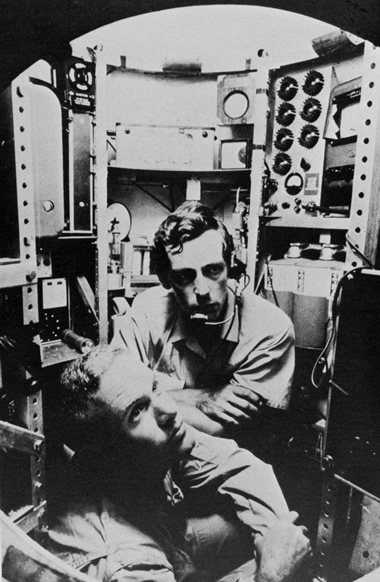Home » Records » Deepest Part of the Ocean » Bathyscaphe Trieste
First Trip to the Deepest Part of the Ocean
The Bathyscaphe Trieste carried two hydronauts to the Challenger Deep in 1960

Bathyscaphe Trieste: The Bathyscaphe Trieste lifted out of the water, circa 1958-59. U.S. Naval Historical Center Photograph.
On January 23, 1960, Jacques Piccard and Don Walsh boarded the Bathyscaphe Trieste sea vessel and descended to the deepest part of the ocean: The Challenger Deep in the Mariana Trench.

Where is the Mariana Trench? The Mariana Trench is located in the western Pacific Ocean. It was discovered to be 10,924 meters deep in 1951 by researchers aboard the British survey ship Challenger. Trieste was the first vehicle to explore the trench with a crew of two people. Map by Geology.com and MapResources.
The Ship: The Bathyscaphe Trieste
A bathyscaphe (pronounced BA-thi-skaf; meaning: "deep ship") is a submersible vessel with a spherical room for research and observation. This observation chamber is attached to the bottom of a tank filled with gasoline. Gasoline is more buoyant than water and is highly resistant to compression, which makes it well-suited for the high pressure of deep-sea dives.
Trieste (pronounced TREE-est-a) was the name given to the bathyscaphe that would make history by traveling into the Challenger Deep on January 23, 1960. It was named after the city in which it was built, on the border between Italy and Yugoslavia. The Trieste carried hydronauts Don Walsh and Jacques Piccard approximately 11,000 meters underwater - that is, about 11 kilometers (or 7 miles) into the deepest part of the Pacific Ocean.
The ship's instruments initially registered the vessel's depth to be 11,521 meters, but this was later recalculated to 10,916 meters. More recent measurements indicate the bottom of the Challenger Deep to be roughly 11,000 meters below sea level.

Mariana Trench Cross-Section: The Mariana Trench is the boundary between two tectonic plates: the Pacific Plate and the Mariana Plate. Image by NOAA.
The Deepest Part of the Ocean: Challenger Deep
The lowest point on the surface of the Earth's crust is underwater, in the western North Pacific Ocean. There is a convergent plate boundary where the Pacific Plate is being forced down into the mantle beneath the Mariana Plate. At this type of plate boundary, an elongated depression called a "trench" is formed - in this case, it is the Mariana Trench. (See map and illustration.)
Within the Mariana Trench, there is a small valley that goes even farther into the Earth's crust - this spot, called the Challenger Deep, is the deepest part of the ocean. The distance between the ocean's surface and the bottom of the Challenger Deep (11,000 meters) is greater than the height of Mount Everest (8,850 meters). That means if you were to put the world's highest mountain inside the deepest part of the ocean, the mountain's peak would still be more than 2 kilometers underwater!

Don Walsh and Jacques Piccard: Lieutenant Don Walsh, USN, and Jacques Piccard in the bathyscaphe TRIESTE. Location: Mariana Trench, 1960. NOAA Ship Collection.
The Explorers: Don Walsh and Jacques Piccard
Oceanographer Jacques Piccard (1922-2008) worked with his father Auguste to design the Trieste. Auguste Piccard, a scientist from Switzerland, had experimented with buoyancy methods for his balloon flights - in fact, he broke the record for the highest altitude balloon flight in 1931-1932. He applied this knowledge about buoyancy to design the Trieste. So, interestingly, at one point in time the Piccard family held the record for both the highest altitude balloon flight and the deepest ocean dive.
Oceanographer Don Walsh (1931-2023), a Lieutenant of the United States Navy, was the other explorer in the Bathyscaphe Trieste's small pressure sphere. He spent over 50 years in oceanic research, and is celebrated by Life magazine as one of the world's great explorers.
The Voyage
The descent into the Challenger Deep took nearly five hours. Once the Bathyscaphe Trieste reached the sea floor, Walsh and Piccard observed their surroundings. The ship's light allowed them to see what they described as a dark brown "diatomaceous ooze" covering the sea floor, along with shrimp and some fish that appeared to resemble flounder and sole. Since the Plexiglas viewing window had cracked during the descent, the men were only able to spend about twenty minutes on the sea floor. Then, they unloaded the ballasts (nine tons of iron pellets, and tanks filled with water) and began to float back to the ocean's surface. The ascent was much quicker than the dive, taking only three hours and fifteen minutes.
For over 50 years, Jacques Piccard and Don Walsh were the only people who had ever seen the deepest part of the ocean firsthand.
Since this monumental voyage, unmanned, remotely operated crafts have ventured into the Challenger Deep - such as Kaiko in the late 1990s, and Nereus in 2009. No other human beings had traveled to the bottom of the Mariana Trench until 2012, when Canadian film director James Cameron made history as the first person to make a solo trip to the Challenger Deep in the Deepsea Challenger. Then in 2019, American explorer Victor Vescovo descended to a record 10,928 meters in the Limiting Factor. He was the first person to make the dive more than once.
There will surely be more manned expeditions in the future. However, there will always be a special place in history for the two men who were brave enough to risk their lives back in 1960 and prove that the trip was possible.
| More Earth Extremes |
 |
The World*s Largest Highly Acidic Lake |
 |
The Tallest Waterfall in the U.S. |
 |
The Most Explosive Eruption |
 |
Largest Volcano - |
 |
Angel Falls |
 |
Deepest Lake in the World |
 |
Bathyscaphe Trieste |
 |
World Record Lightning |

Find Other Topics on Geology.com:

|

| ||

|

| ||

|

| ||

|

|
